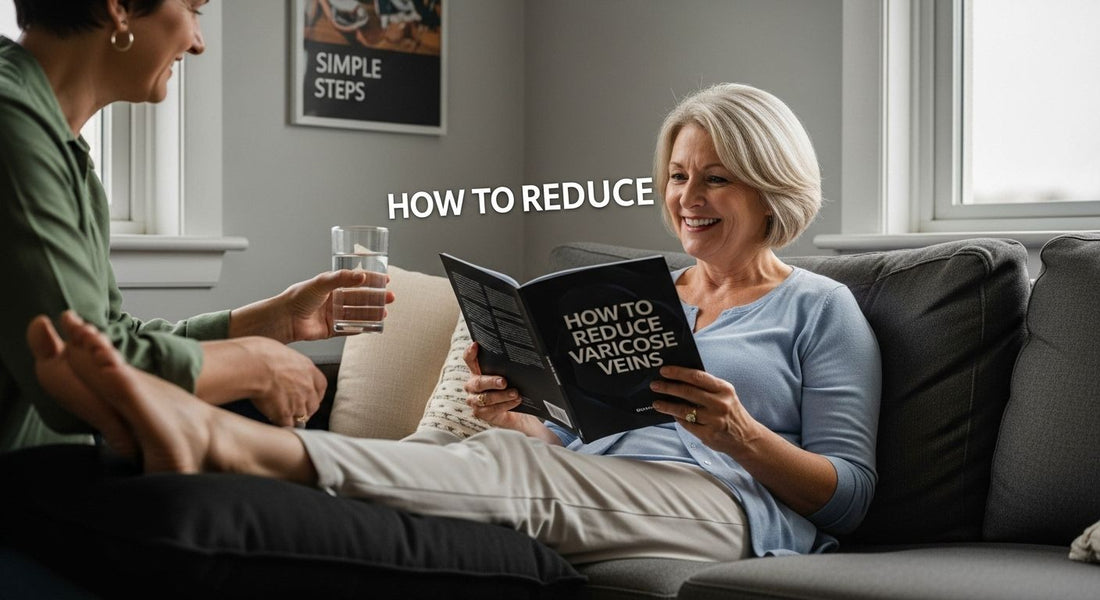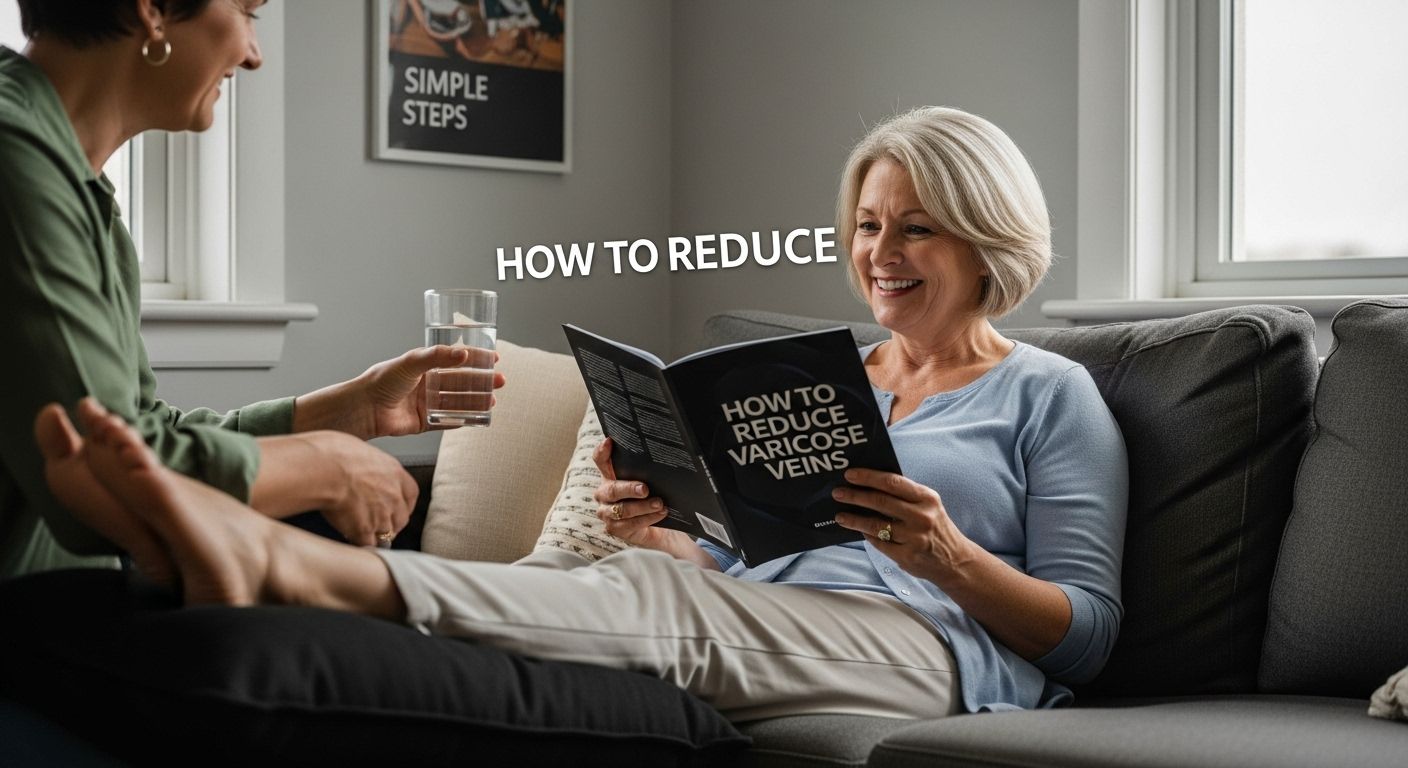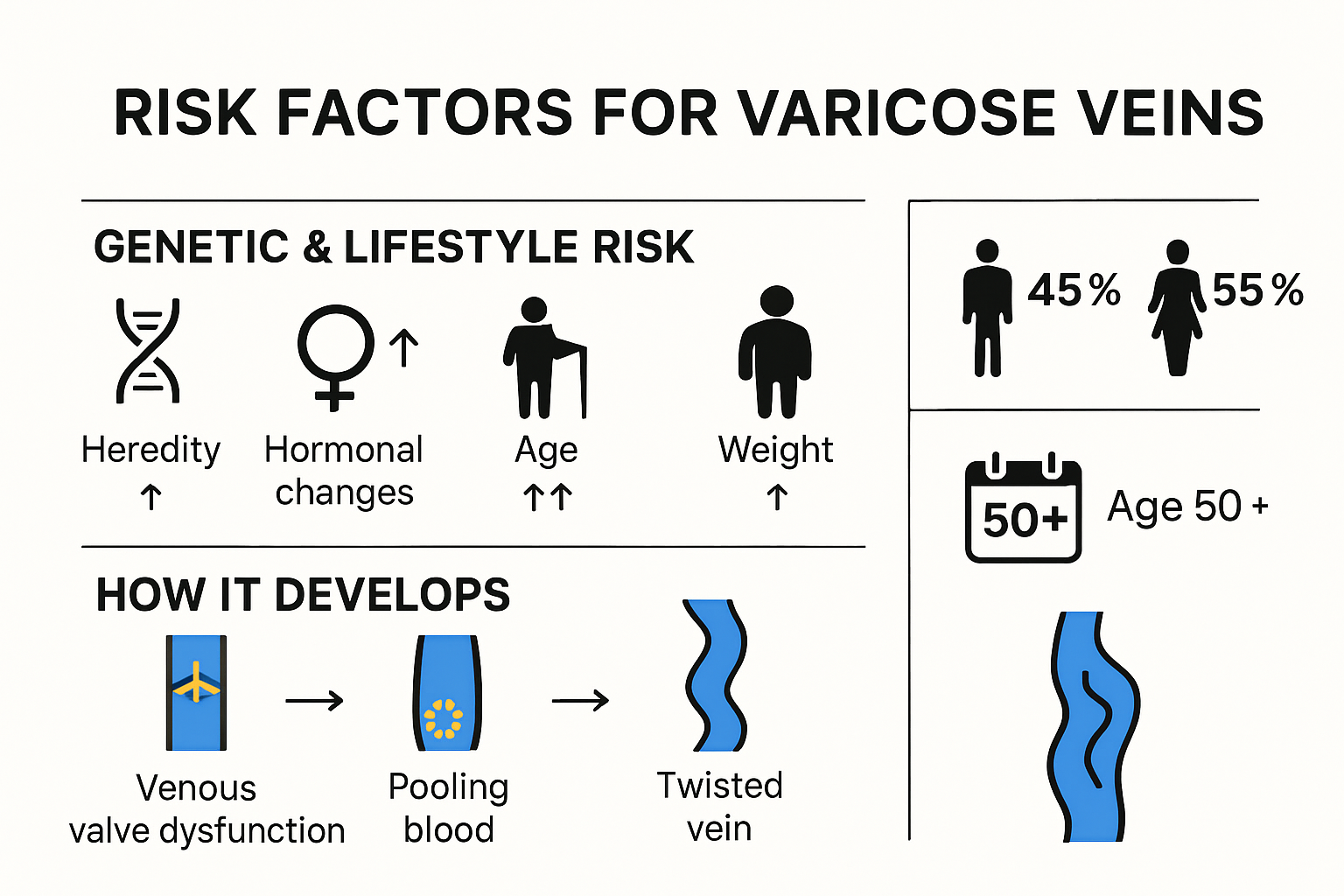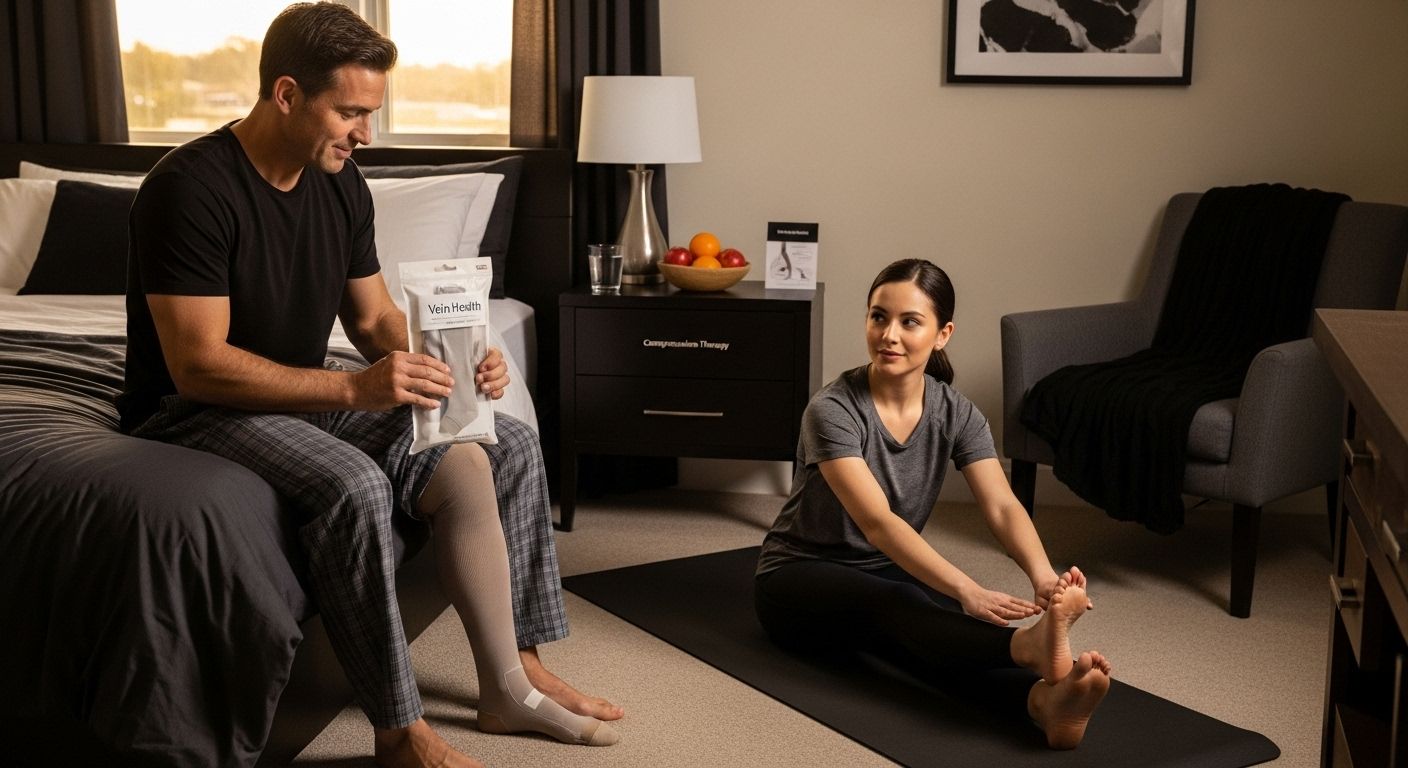
How to Reduce Varicose Veins: Simple Steps for Relief
Share

Varicose veins affect up to 35 percent of adults in the United States and they are more than just a visual concern for many people. Most folks expect them to just appear as they age or blame genetics and think there is little they can do. But fresh studies show that daily habits and simple home remedies can actually ease discomfort and slow things down. Surprising, right
Table of Contents
- Understanding What Causes Varicose Veins
- Effective Home Remedies and Daily Habits
- Compression Therapy and Support Options
- When to Seek Professional Vein Treatment
Quick Summary
| Takeaway | Explanation |
|---|---|
| Understand genetic and lifestyle risks | Recognizing factors like genetics, age, weight, and occupation can help prevent varicose veins. |
| Adopt daily comfort strategies | Elevate legs regularly and engage in exercises to boost circulation and reduce swelling. |
| Choose appropriate compression wear | Use compression stockings based on the severity of your condition to enhance blood flow and alleviate symptoms. |
| Seek medical advice for severe symptoms | Recognize warning signs like severe pain or skin changes, and consult a specialist for proper treatment options. |
| Combine treatments for best results | Integrate lifestyle changes with medical treatments for comprehensive management of varicose veins. |
Understanding What Causes Varicose Veins
Varicose veins are more than just a cosmetic concern. They represent a complex vascular condition rooted in the intricate mechanics of our circulatory system. Understanding the underlying causes can help individuals recognize risk factors and take proactive steps toward prevention and management.
The Anatomy of Vein Dysfunction
At the core of varicose vein development is a fundamental problem with how blood circulates through the leg veins. According to the National Heart, Lung, and Blood Institute, these veins contain tiny valves designed to prevent blood from flowing backward. When these valves become weak or damaged, blood begins to pool in the veins, causing them to stretch, enlarge, and become visible beneath the skin.
The process is not sudden but gradual. Healthy veins work against gravity, pushing blood upward through one-way valves. When these valves fail, blood begins to collect instead of moving efficiently, creating the characteristic twisted and bulging appearance of varicose veins. This venous reflux leads to increased pressure within the vein walls, causing them to expand and become more prominent.
Key Risk Factors
Genetic Predisposition plays a significant role in varicose vein development. Research from the National Center for Biotechnology Information highlights that if your parents or grandparents experienced varicose veins, you are more likely to develop them.
Several critical factors contribute to varicose vein formation:
- Hormonal Changes: Pregnancy and menopause can significantly impact vein health
- Age: Risk increases as blood vessels naturally lose elasticity
- Occupation: Prolonged standing or sitting can impair blood circulation
- Weight: Excess body weight adds additional pressure on leg veins
The Mayo Clinic confirms that women are more susceptible to varicose veins due to hormonal fluctuations that can relax vein walls. Additionally, medical experts note that lifestyle and physiological changes dramatically influence vein health.
To better understand the different risk factors that contribute to varicose vein development, refer to the following summary table:
| Risk Factor | Description |
|---|---|
| Genetics | Family history of varicose veins increases personal risk |
| Hormonal Changes | Pregnancy and menopause can relax vein walls |
| Age | Aging causes blood vessels to lose elasticity |
| Occupation | Jobs requiring prolonged standing or sitting impair circulation |
| Weight | Excess body weight adds pressure to leg veins |
| Gender | Women are more susceptible due to hormonal fluctuations |
Understanding these causes empowers individuals to make informed decisions about prevention and potential treatment. While some risk factors like genetics cannot be controlled, many lifestyle modifications can help reduce the likelihood of developing varicose veins.

Learn more about improving leg circulation and discover strategies to support your vascular health proactively.
Effective Home Remedies and Daily Habits
Managing varicose veins involves more than medical interventions. Daily lifestyle choices and simple home strategies can significantly impact vein health and reduce discomfort. By incorporating targeted practices, individuals can support their circulatory system and potentially slow the progression of varicose veins.
Lifestyle Modifications for Vein Health
According to Medical News Today, several practical approaches can help manage varicose vein symptoms. Exercise emerges as a critical intervention, promoting blood circulation and muscle strength. Low-impact activities like walking, swimming, and cycling can improve venous return without placing excessive strain on the legs.
Dietary choices play a crucial role in supporting vascular health. The Cleveland Clinic highlights the importance of consuming foods rich in flavonoids, such as hot peppers, green tea, and buckwheat. These nutrients may help lower blood pressure and enhance circulation, potentially reducing vein inflammation and discomfort.
Natural Strategies for Symptom Management
Elevating the legs remains a simple yet effective strategy for reducing venous pressure. When resting, positioning your legs above heart level can help blood flow back to the heart more efficiently, minimizing swelling and discomfort. Aim to do this for 15-20 minutes several times daily, especially after prolonged standing or sitting.
HealthPartners recommends specific exercises that can support vein health:
- Ankle Rotations: Improve blood circulation in lower legs
- Leg Lifts: Strengthen muscles and support venous return
- Walking: Promotes consistent blood flow and muscle engagement
Weight management also plays a critical role. Excess body weight increases pressure on leg veins, exacerbating varicose vein symptoms. Maintaining a healthy weight through balanced nutrition and regular physical activity can significantly reduce strain on your circulatory system.
Daily Comfort and Prevention
Compression wear offers another practical approach to managing varicose veins. Learn more about selecting the right compression socks for everyday use to support your vascular health. These garments provide graduated pressure, helping blood move more efficiently from the legs back to the heart.
Consistent hydration and a diet high in fiber can also contribute to overall vascular health. Drinking adequate water helps maintain blood viscosity, while fiber-rich foods can prevent constipation, which can increase abdominal pressure and potentially worsen varicose veins.
Remember, while these strategies can help manage symptoms, they are not a substitute for professional medical advice. Always consult with a healthcare provider for personalized guidance tailored to your specific condition and health needs.
Compression Therapy and Support Options
Compression therapy represents a cornerstone treatment for managing varicose veins, offering both therapeutic relief and preventive support. By understanding the various compression options and their specific benefits, individuals can make informed decisions about managing their vascular health.
Understanding Compression Levels
According to the Mayo Clinic, compression stockings work by steadily squeezing legs to help veins and leg muscles move blood more efficiently. These specialized garments come in different compression levels, measured in millimeters of mercury (mmHg), which determine their therapeutic intensity.
Compression levels typically range from mild to extra firm:
Compression stockings come in various levels suitable for different needs. This comparison table outlines the main types and their recommended uses:
| Compression Level | mmHg Range | Recommended For |
|---|---|---|
| Mild Compression | 15-20 mmHg | Everyday use, prevention, mild symptoms |
| Moderate Compression | 20-30 mmHg | Managing mild varicose veins, preventing progression |
| Firm Compression | 30-40 mmHg | Severe varicose veins, significant circulatory issues |
- Mild Compression (15-20 mmHg): Ideal for everyday use and preventive care
- Moderate Compression (20-30 mmHg): Recommended for managing mild varicose veins and preventing progression
- Firm Compression (30-40 mmHg): Designed for more severe varicose veins and significant circulatory issues
Selecting the Right Compression Support
Choosing appropriate compression wear requires careful consideration of individual needs. Learn more about finding the perfect compression stocking fit to ensure maximum effectiveness and comfort. Factors to consider include the severity of varicose veins, lifestyle, and personal comfort preferences.
Key considerations when selecting compression stockings include:
- Fabric Material: Breathable materials like nylon and spandex offer comfort and durability
- Length: Knee-high, thigh-high, and full-length options address different circulatory needs
- Style: Open-toe or closed-toe designs based on personal preference
Benefits Beyond Symptom Management
Research in compression therapy reveals multiple advantages beyond varicose vein management. These garments not only improve blood circulation but also:
- Reduce leg swelling and inflammation
- Prevent blood clot formation
- Minimize leg fatigue during prolonged standing or sitting
- Support muscle recovery after physical activity
Professional medical consultation remains crucial in determining the most appropriate compression level and style. Healthcare providers can assess individual needs and recommend personalized compression solutions that align with specific medical conditions and lifestyle requirements.
While compression therapy offers significant benefits, it should be viewed as part of a comprehensive approach to vascular health. Combining these support options with lifestyle modifications, regular exercise, and a balanced diet can provide the most effective strategy for managing varicose veins.

When to Seek Professional Vein Treatment
While many varicose vein symptoms can be managed through lifestyle modifications and home remedies, certain situations demand professional medical intervention. Understanding when to transition from self-care to specialized treatment is crucial for preventing potential complications and maintaining long-term vascular health.
Warning Signs Requiring Medical Attention
According to the Mayo Clinic, several critical indicators suggest it’s time to consult a vein specialist. These warning signs extend beyond cosmetic concerns and indicate potential underlying health risks.
Immediate medical consultation becomes necessary when experiencing:
- Severe Pain: Persistent or intensifying leg discomfort that interrupts daily activities
- Skin Changes: Discoloration, hardening, or inflammation around varicose veins
- Bleeding: Spontaneous bleeding from varicose veins
- Ulceration: Development of open wounds or skin ulcers near affected veins
- Significant Swelling: Continuous leg swelling that does not improve with elevation
Professional Diagnostic and Treatment Options
Vein specialists employ multiple diagnostic techniques to assess varicose vein severity and recommend appropriate treatments. Diagnostic methods typically include:
- Detailed physical examination
- Ultrasound imaging to evaluate blood flow
- Venous pressure measurements
- Comprehensive medical history review
Depending on the assessment, healthcare professionals might recommend various treatment strategies:
- Sclerotherapy: Injection of special solution to close problematic veins
- Laser Treatments: Non-invasive procedures targeting smaller varicose veins
- Radiofrequency Ablation: Using heat to seal damaged veins
- Surgical Interventions: Vein stripping or more complex procedures for severe cases
Understanding Treatment Considerations
Professional treatments are not one-size-fits-all. Learn more about managing vein health comprehensively to understand how different approaches can be tailored to individual needs.
Factors influencing treatment recommendations include:
- Patient’s overall health status
- Age and medical history
- Extent of vein damage
- Potential risk of complications
- Individual lifestyle and activity levels
It’s essential to approach vein treatment holistically. While medical procedures can address existing issues, maintaining healthy lifestyle habits remains crucial for preventing future vascular problems. Always consult with board-certified vascular specialists who can provide personalized guidance aligned with your specific health requirements.
Remember, early intervention can prevent more serious complications and improve overall leg health. Do not hesitate to seek professional advice if you are experiencing persistent or worsening varicose vein symptoms.
Frequently Asked Questions
What are the main causes of varicose veins?
Varicose veins are mainly caused by weakened or damaged valves in the veins that lead to blood pooling. Factors such as genetics, hormonal changes, age, prolonged standing or sitting, excess weight, and gender can contribute to their development.
How can lifestyle modifications help manage varicose veins?
Lifestyle modifications, such as regular low-impact exercise, maintaining a healthy weight, elevating the legs, and consuming a diet rich in flavonoids, can significantly enhance blood circulation and reduce discomfort associated with varicose veins.
What are compression stockings, and how do they help with varicose veins?
Compression stockings are specialized garments that apply graduated pressure to the legs, helping to improve blood flow and reduce swelling. They are available in various compression levels, which can be chosen based on the severity of varicose veins.
When should I seek medical treatment for varicose veins?
You should seek medical treatment if you experience severe pain, skin changes, spontaneous bleeding, ulceration, or significant swelling that does not improve with home treatments or lifestyle changes. Consulting a vein specialist is crucial to receive appropriate care.
Take Action Against Varicose Vein Discomfort With Medical-Grade Solutions
If you are tired of the ache, swelling, and visible veins discussed in this guide, now is the time to make circulation support a daily routine. Finding the right compression wear does not have to be confusing or overwhelming. At Fit Stockings, you will find medical-grade compression stockings tailored for varicose veins, with the trusted brands, accurate sizing, and guidance mentioned throughout this article. Every pair is crafted to target the venous reflux and swelling you want to reduce. You can choose from various compression levels, styles, and easy-to-wear options that were highlighted as effective solutions here.
Why wait to feel better? Experience relief at home and get back to feeling comfortable in your own skin. Explore our full range of doctor-recommended products and expert resources at Fit Stockings. Need help choosing? Start with our tips on selecting the perfect compression stocking fit. Take the first step now to ease your symptoms and move forward with renewed confidence.
Recommended
- What Is Compression Therapy? Guide for Vein & Leg Health 2025 – Fit Stockings
- Can Compression Stockings Help Spider Veins? Benefit Guide 2025 – Fit Stockings
- Top Compression Garments Benefits for Vein Health and Recovery 2025 – Fit Stockings
- How to Boost Leg Circulation: Tips for Healthy Legs – Fit Stockings

